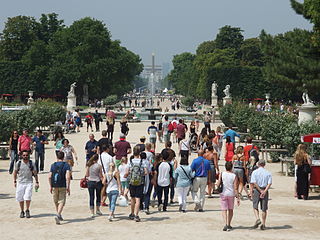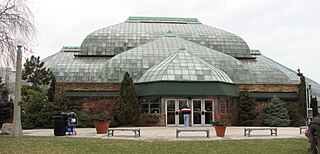
East Ruston is a village and a civil parish in the English county of Norfolk. The village is located 4.1 miles (6.6 km) south-east of North Walsham and 14 miles (23 km) north-east of Norwich.

The Tuileries Garden is a public garden located between the Louvre and the Place de la Concorde in the 1st arrondissement of Paris, France. Created by Catherine de' Medici as the garden of the Tuileries Palace in 1564, it was eventually opened to the public in 1667 and became a public park after the French Revolution. Since the 19th century, it has been a place where Parisians celebrate, meet, stroll and relax.
The Mizzou Botanic Garden contains thousands of plants within the campus of the University of Missouri in Columbia, Missouri, United States. The Garden includes famous icons, such as Thomas Jefferson's original grave marker and the Columns of Academic Hall, and is open year-round, only asking for a small donation to visit.

Powell Gardens, Kansas City's botanical garden, is a 970-acre (3.9 km2) botanical garden in Kingsville, Missouri, United States, 30 miles (48 km) east of Kansas City. It features 6,000 varieties of plants, with 225,000 plants in seasonal displays, and is open to the public, for a fee, during daylight hours.

Ruston & Hornsby was an industrial equipment manufacturer in Lincoln, England founded in 1918. The company is best known as a manufacturer of narrow and standard gauge diesel locomotives and also of steam shovels. Other products included cars, steam locomotives and a range of internal combustion engines, and later gas turbines. It is now a subsidiary of Siemens.

Queen Elizabeth Park is a 130-acre municipal park located in Vancouver, British Columbia, Canada. It is located on top of Little Mountain approximately 125 metres (410 ft) above sea level and is the location of former basalt quarries dug in the beginning of the twentieth century to provide materials for roads in the city.

Century Park is the biggest park in the city of Shanghai. It is situated on Jinxiu Road, in the Pudong New Area of Shanghai, nearby to the Shanghai Science and Technology Museum.

The New Orleans Botanical Garden is a botanical garden located in City Park, New Orleans, Louisiana. The first classical garden in New Orleans, it was funded by the Works Progress Administration.

The Lincoln Park Conservatory is a conservatory and botanical garden in Lincoln Park in Chicago, Illinois. The conservatory is located at 2391 North Stockton Drive just south of Fullerton Avenue, west of Lake Shore Drive, and part of the Lincoln Park, Chicago community area. The Alfred Caldwell Lily Pool and the North Pond Nature Sanctuary are further to the north along Stockton Drive. Along with the Garfield Park Conservatory on Chicago's west side, the Lincoln Park Conservatory provides significant horticultural collections, educational programs and community outreach efforts.

The Villa Ephrussi de Rothschild, also called Villa Île-de-France, is a French seaside villa located at Saint-Jean-Cap-Ferrat on the French Riviera. Designed by the French architect Aaron Messiah, it was built between 1907 and 1912 by Baroness Béatrice de Rothschild (1864–1934).

The Morris Arboretum & Gardens of the University of Pennsylvania is the official arboretum of the Commonwealth of Pennsylvania. The Arboretum is open daily except for major holidays. It is located at 100 East Northwestern Avenue, Chestnut Hill, Philadelphia, Pennsylvania.

Las Pozas is a surrealistic group of structures created by Edward James, more than 2,000 feet (610 m) above sea level, in a subtropical rainforest in the Sierra Gorda mountains of Mexico. It includes more than 80 acres (32 ha) of natural waterfalls and pools interlaced with towering surrealist sculptures in concrete.

A rose garden or rosarium is a garden or park, often open to the public, used to present and grow various types of garden roses, and sometimes rose species. Designs vary tremendously and roses may be displayed alongside other plants or grouped by individual variety, colour or class in rose beds. Technically it is a specialized type of shrub garden, but normally treated as a type of flower garden, if only because its origins in Europe go back to at least the Middle Ages in Europe, when roses were effectively the largest and most popular flowers, already existing in numerous garden cultivars.

With an area of more than 30 hectares, the Hohenheim Gardens are the largest part of the campus of the University of Hohenheim in Stuttgart, Baden-Württemberg, Germany. The oldest part of the garden, the Exotic Garden or Franziskas Dörfle, was established in 1776 by Duke Carl Eugen von Württemberg and Franziska von Hohenheim. Today, the Hohenheim Gardens are home to around 3000 taxa of woody plants as well as numerous monuments and works of art from four centuries. Over 150 woody plants are more than 100 years old. The Hohenheim Gardens are open all year round, all day and free of charge.

The Flora und Botanischer Garten Köln is a municipal formal park and botanical garden located adjacent to Cologne Zoological Garden at Amsterdamer Straße 34, Cologne, North Rhine-Westphalia, Germany. It is open daily without charge.

Emily Louisa Merielina White was a New Zealand gardener and writer. She contributed to community life in New Zealand and was one of New Zealand's first notable gardening authors.

The Baroque garden was a style of garden based upon symmetry and the principle of imposing order on nature. The style originated in the late-16th century in Italy, in the gardens of the Vatican and the Villa Borghese gardens in Rome and in the gardens of the Villa d'Este in Tivoli, and then spread to France, where it became known as the jardin à la française or French formal garden. The grandest example is found in the Gardens of Versailles designed during the 17th century by the landscape architect André Le Nôtre for Louis XIV. In the 18th century, in imitation of Versailles, very ornate Baroque gardens were built in other parts of Europe, including Germany, Austria, Spain, and in Saint-Petersburg, Russia. In the mid-18th century the style was replaced by the less geometric and more natural English landscape garden.

Paris today has more than 421 municipal parks and gardens, covering more than three thousand hectares and containing more than 250,000 trees. Two of Paris's oldest and most famous gardens are the Tuileries Garden, created in 1564 for the Tuileries Palace, and redone by André Le Nôtre in 1664; and the Luxembourg Garden, belonging to a château built for Marie de' Medici in 1612, which today houses the French Senate. The Jardin des Plantes was the first botanical garden in Paris, created in 1626 by Louis XIII's doctor Guy de La Brosse for the cultivation of medicinal plants. Between 1853 and 1870, the Emperor Napoleon III and the city's first director of parks and gardens, Jean-Charles Adolphe Alphand, created the Bois de Boulogne, the Bois de Vincennes, Parc Montsouris and the Parc des Buttes Chaumont, located at the four points of the compass around the city, as well as many smaller parks, squares and gardens in the neighborhoods of the city. One hundred sixty-six new parks have been created since 1977, most notably the Parc de la Villette (1987–1991) and Parc André Citroën (1992).

The Louis XIV style or Louis Quatorze, also called French classicism, was the style of architecture and decorative arts intended to glorify King Louis XIV and his reign. It featured majesty, harmony and regularity. It became the official style during the reign of Louis XIV (1643–1715), imposed upon artists by the newly established Académie royale de peinture et de sculpture and the Académie royale d'architecture. It had an important influence upon the architecture of other European monarchs, from Frederick the Great of Prussia to Peter the Great of Russia. Major architects of the period included François Mansart, Jules Hardouin Mansart, Robert de Cotte, Pierre Le Muet, Claude Perrault, and Louis Le Vau. Major monuments included the Palace of Versailles, the Grand Trianon at Versailles, and the Church of Les Invalides (1675–1691).



















